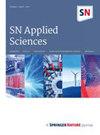Assessment of three mixed arrays dataset for subsurface cavities detection using resistivity tomography as inferred from numerical modelling
IF 2.4
Q2 MULTIDISCIPLINARY SCIENCES
引用次数: 0
Abstract
Abstract The present study deals with the evaluation of a three-mixed array dataset for the detection of subsurface cavities using conceptual air-filled cavity model sets at different depths. Cavity models were simulated using the forward modelling technique to generate synthetic apparent resistivity data for three common individual arrays. These arrays are dipole–dipole (DD), pole–dipole (PD), and Wenner–Schlumberger (WS). The synthetically apparent resistivity data obtained from two different individual arrays were merged to form a high-resolution single model. Consequently, three possible mixed arrays datasets can be obtained: the dipole–dipole-Wenner–Schlumberger (DD+WS), pole–dipole, and Wenner–Schlumberger (PD+WS), and dipole–dipole and pole–dipole (DD+PD). The synthetically apparent resistivity data for both the individual and mixed arrays were inverted using Res2dinv software based on the robust constrain inversion technique to obtain a 2D resistivity model section. The inverted resistivity sections were evaluated in terms of their recovering ability of the model’s parameters (e.g. resistivity, and geometry). The results show that the individual arrays can resolve the location and dimensions of the cavity within reasonable accuracy only at a depth not exceeding 6 m below the surface. On the other hand, a significant resolution enhancement in model resistivity with increasing depth was observed when the mixed arrays were used. The (DD+WS) mixed arrays dataset brings up better model resistivity and shows closer parameters to the true actual model among the other mixed arrays. So it is strongly recommended for cavity detection studies.利用数值模拟推断的电阻率层析成像法探测地下空腔的三个混合阵列数据集的评估
摘要:本研究利用不同深度的概念充气空腔模型集对三混合阵列数据集进行了评估。利用正演模拟技术对空腔模型进行了模拟,生成了三种常见单独阵列的综合视电阻率数据。这些阵列包括偶极-偶极(DD)、极-偶极(PD)和温纳-斯伦贝谢(WS)。从两个不同的单独阵列获得的综合视电阻率数据被合并成一个高分辨率的单一模型。因此,可以获得三种可能的混合阵列数据集:偶极子-偶极子-温纳-斯伦贝谢(DD+WS),极子-偶极子和温纳-斯伦贝谢(PD+WS),以及偶极子-偶极子和极子-偶极子(DD+PD)。利用基于鲁棒约束反演技术的Res2dinv软件反演单个和混合阵列的综合视电阻率数据,得到二维电阻率模型剖面。根据模型参数(如电阻率和几何形状)的恢复能力对反演电阻率剖面进行了评价。结果表明,单个阵列只能在地表以下不超过6 m的深度内以合理的精度解析空腔的位置和尺寸。另一方面,当使用混合阵列时,模型电阻率分辨率随深度的增加而显著增强。在其他混合阵列中,(DD+WS)混合阵列数据集的模型电阻率更好,参数更接近真实实际模型。因此强烈推荐用于腔体检测研究。
本文章由计算机程序翻译,如有差异,请以英文原文为准。
求助全文
约1分钟内获得全文
求助全文

 求助内容:
求助内容: 应助结果提醒方式:
应助结果提醒方式:


